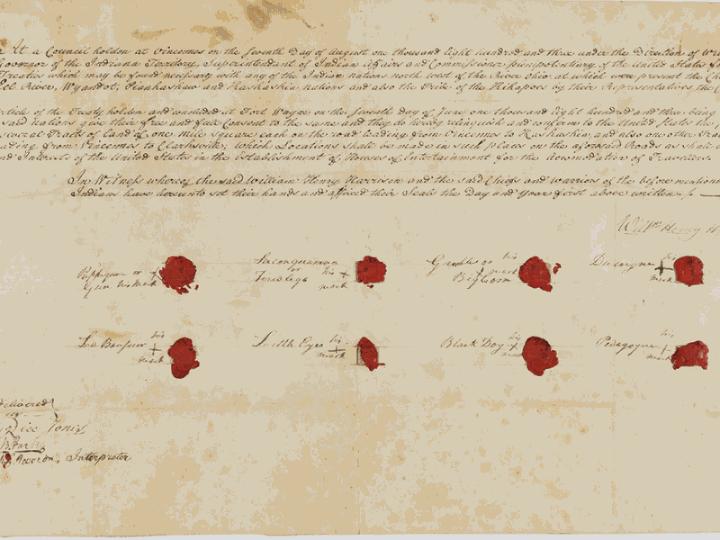 |
Canku Ota
|
 |
|
(Many Paths)
|
||
|
An Online Newsletter
Celebrating Native America
|
||
|
OCTOBER 2020 - Volume
18 Number 10
|
||
|
|
||
|
Hundreds Of Native
American Treaties Digitized For The First Time
|
||
|
by Nora McGreevy - SMITHSONIANMAG.COM
|
||
|
The National Archives
has scanned more than 300 agreements between the United States and
Indigenous tribes
For many Native American tribes, historical treaties are a fraught reminder of promises made—and broken—by the United States government over centuries of colonial expansion and exploitation. The documents are also of paramount importance today, as tribes and activists point to them as binding agreements in legal battles for land and resources. Thanks to a newly completed digitization effort by the U.S. National Archives and the Museum of Indian Arts and Culture (MIAC) in Santa Fe, researchers and the public now have unprecedented access to hundreds of these critical agreements. The online collection features 374 ratified Indian treaties from the archives’ holdings. According to a blog post, these documents are housed in a specially protected area of the National Archives building and are unavailable for use in the Central Research Room due to their fragility and significance. More than 50 of the treaties are written on large sheets of parchment; several contain drawings, maps and wampum, or decorative beads used as currency in some Native American tribes. Those hoping to delve into the trove can use Indigenous Digital Archive (IDA) Treaties Explorer, a free tool optimized for easily searching and studying the documents. In addition to providing a framework for research, the portal offers maps of different treaty land designations, as well as extensive historical and contextual information. “The treaties between the U.S. and Native nations are relevant, and few people have had access to know about treaties that are related to where they live,” Della Warrior, MIAC’s director and a member of the Otoe-Missouria tribe, tells the Albuquerque Journal’s Adrian Gomez. “MIAC is pleased to be able to provide this online resource that we all can use to explore our relationships using maps and a carefully curated set of historical documents from the National Archives, the Library of Congress, the Smithsonian, and other sources.”
In addition to debuting the new resource, MIAC recently hosted a series of Facebook workshops on treaty law. Led by Sherri Thomas, assistant director of the University of New Mexico Law Library, the recorded sessions are now available to view online. The digitization project was completed with funding from an anonymous donor, says David S. Ferriero, archivist of the United States, in a statement. “Of all the things we have custody of and are responsible for—even the Charters of Freedom—I believe the Indian treaties are the most valuable documents in terms of reading the original language and the government promises, and realizing what was never delivered,” he adds. “Now, many more descendants of the original peoples can examine the names and seals and read the words set down by their ancestors so long ago.” “Of all the things we have custody of and are responsible for—even the Charters of Freedom—I believe the Indian treaties are the most valuable documents in terms of reading the original language and the government promises, and realizing what was never delivered,” he adds. “Now, many more descendants of the original peoples can examine the names and seals and read the words set down by their ancestors so long ago.” Today, treaties play key roles in disputes over land and water rights. As Kimbra Cutlip reported for Smithsonian magazine in 2018, a group of Native American tribes has long contested its right to land in South Dakota’s Black Hills. The tribes’ argument hinges on the Fort Laramie Treaty, an 1868 legal document forged between a collective of Native American bands—including the Dakota, Lakota, Nakota and Arapaho—and the U.S. government. Though officials had initially designated the Black Hills as land reserved for Native use, they reneged on the treaty when gold was discovered in the region less than a decade later. The importance of historic Native American treaties once again surfaced in the news in July, when the Supreme Court ruled that much of the eastern half of Oklahoma falls within Native American territory. Though no land changed hands, the McGirt v. Oklahoma decision was hailed as a win for tribal sovereignty because it demonstrated that Native reservations established by treaties with the U.S. in the 1830s were still valid despite the fact that Oklahoma became a state in 1907. “This is a historic day,” Creek Nation Principal Chief David Hill told the New York Times’ Jack Healy and Adam Liptak shortly after the announcement. “This is amazing. It’s never too late to make things right.”
National
Archives IDA
Treaties Explorer |
|||||
|
|
||
|
|
||
| Canku Ota is a free Newsletter celebrating Native America, its traditions and accomplishments . We do not provide subscriber or visitor names to anyone. Some articles presented in Canku Ota may contain copyright material. We have received appropriate permissions for republishing any articles. Material appearing here is distributed without profit or monetary gain to those who have expressed an interest. This is in accordance with Title 17 U.S.C. Section 107. | ||
|
Canku Ota is a copyright ©
2000 - 2020 of Vicki Williams Barry and Paul Barry.
|
||
 |
 |
|
|
The "Canku
Ota - A Newsletter Celebrating Native America" web site and
its design is the
|
||
|
Copyright ©
1999 - 2020 of Paul C. Barry.
|
||
|
All Rights Reserved.
|
||

